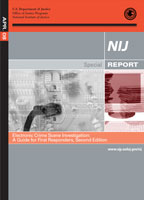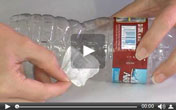|
View in browser: http://www.crime-scene-investigator.net/newsletter/0517.html
|
||
|
MAY 2017 | ||
| ||
|
This Month's Featured Resource on the Crime Scene Investigator Network Website
|
||
 This guide is intended to assist State and local law enforcement and other first responders who may be responsible for preserving an electronic crime scene and for recognizing, collecting, and safeguarding digital evidence. It is not all inclusive but addresses situations encountered with electronic crime scenes and digital evidence. All crime scenes are unique and the judgment of the first responder, agency protocols, and prevailing technology should all be considered when implementing the information in this guide. First responders to electronic crime scenes should adjust their practices as circumstances—including level of experience, conditions, and available equipment—warrant. |
||
|
New CSI and Forensic Job Announcements
|
||
|
The most comprehensive listing of Crime Scene Investigation and Forensic To be notified of job openings as they are posted, follow us on Twitter: Job Posting Alerts |
||
|
Evidence Technician I
Wyoming Police Department, Wyoming, Michigan, USA Final Filing Date: June 9, 2017 Performs detailed and technical identification work required to ensure the proper collection and preservation of evidence. This position is responsible for fingerprinting, photography, computer mapping/graphics, crime scene search/documentation, preservation of evidence, preparing court exhibits, records and reports, and performing related work as required. <View complete job listing> |
||
|
Latent Print and Evidence Specialist
Escondido Police Department, Escondido, California, USA Final Filing Date: Continuous. A first review of applications will take place during the week of June 5, 2017 Identifies, diagrams, photographs, collects, transports and preserves evidence from crime scenes; provides technical guidance and leadership in latent print analysis and performs difficult and complex examination of latent prints in connection with the investigation of crimes; gives expert testimony in the courts in all phases of latent print examination; <View complete job listing> |
||
|
Forensic Scientist
Indiana State Police, Indianapolis, Indiana, USA Final Filing Date: June 15, 2017 An entry level Forensic Scientist performs technical work, testing and analyzing drugs and drugs of abuse and their metabolites for law enforcement and governmental agencies using state of the art instrumentation and analytical techniques. <View complete job listing> |
||
 |
||
|
Forensic Scientist 2 - Latent Fingerprints Analyst
New Mexico Department of Public Safety, Santa Fe, New Mexico, USA Final Filing Date: June 9, 2017 Responsible for independently collecting, classifying, identifying and analyzing latent fingerprint evidence related to criminal investigations. <View complete job listing> |
||
|
Forensic Services Supervisor
Durham Police Department, Durham, North Carolina, USA Final Filing Date: June 16, 2017 The Forensic Services Supervisor performs activities associated with the Police Department's Forensic Services Division and is responsible for the day to day administrative and technical operations of multiple units within the Forensic Services Division (Firearms, Latent Prints and Digital Forensics). <View complete job listing> |
||
|
Medical Examiner Investigator
Macomb County Medical Examiner, Mount Clemens, Michigan, USA Final Filing Date: March 23, 2017June 1, 2017 Performs investigations of deaths that occur within Macomb County; prepares detailed reports and analysis on investigation of cases; ensures that evidence, death scene and specimens are preserved for authenticity in cooperation with local law enforcement activities; works cooperatively with law enforcement agencies, <View complete job listing> |
||
|
Search for more job listings in Crime Scene Investigations and Forensics To be notified of job openings as they are posted, follow us on Twitter: Job Posting Alerts |
||
|
Featured Video Presentation
|
||
|
Learn the basic technique for using Mikrosil to lift fingerprints from irregular surfaces. |
||
|
Other Resources on the Crime Scene Investigator Network Website
|
||
|
Crime Scene Investigator mdash; Blog
Crime Scene Investigator Forum How to Become a Crime Scene Investigator Crime Scene Response Evidence Collection Crime Scene and Evidence Photography Crime Scene Investigation Articles Video Presentations Training and Colleges Employment Bookstore Resources and Links |
||
|
Not Subscribed to this Newsletter?
|
||
|
If you are not subscribed to this newsletter, you may subscribe with this link: SUBSCRIBE via email |
||
|
To Unsubscribe
|
||
|
To unsubscribe from future e-mail newsletters, please click here: UNSUBSCRIBE Copyright ©2017 Crime Scene Resources, Inc. Crime Scene Investigator Network |



